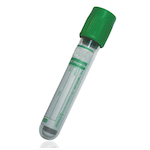Suitable Specimen Types
- Li Hep Plasma
Sample Processing in Laboratory
UsualSample Preparation
Centrifuge sample. Samples should be clot-free and free of red cells or other particulate matter. The presence of fibrin may cause erroneous results.Turnaround Time
< 1 daySample Stability
Samples for CKMB mass analysis are stable only for up to 8 hours if stored at 4 ºC. Samples should ideally be stored frozen at -20 ºC prior to analysis or for longer periods. Samples should not be repeatedly frozen and thawed.CK-MB (Mass)
General Information
Please note, this is no longer a routine test. If you suspect that your patient has had a heart attack, for biochemical conformation please request a Troponin T.Creatine Kinase (CK, CPK) is an enzyme found primarily in the heart and skeletal muscles, and to a lesser extent in the brain. Significant injury to any of these structures will lead to a measurable increase in CK levels. Elevations in CK are found in:
- Myocardial infarction
- Crushing muscular trauma
- Any cardiac or muscle disease, but not myesthenia gravis or multiple sclerosus
- Brain injury
CK enzymes consist of two subunits, which can be either B (brain type) or M (muscle type). There are therefore three different isoenzymes: CK-MM (CK-3), CK-BB (CK-1) and CK-MB (CK-2). CK-BB is found mostly in the brain and lungs, CK-MB is found mostly in the heart while CK-MM is found mostly in skeletal muscle.
CK-MB is sometimes called the cardiac isoenzyme as 10 to 20% of the total CK activity in the myocardium is from CK-MB. Therefore CK–MB levels, along with total CK, may be tested in persons who have chest pain to diagnose whether they have had a heart attack. A high total CK could indicate damage to either the heart or other muscles, but because CK-MB comes from the heart, a high CK–MB suggests that the damage was to heart muscle.
However, recommendations state that CK-MB should only be measured in clinical laboratories that cannot implement troponin testing rapidly. Although there is suggestions that CK-MB may be using together with Troponin T for assiting in timing onset or myocardial injury, infarct sizing or determination of reinfarction, there is no strong evidence for dual testing.
If you suspect that your patient has had a heart attack, for biochemical conformation please request a Troponin T.
Patient Preparation
Samples from patients receiving high biotin doses (>5 mg/day) should be taken at least 8 hours post dose.Notes
Haemolysis causes interference with this assay.Reference Range
American College of Cardiology/European Society of Cardiology suggest setting cardiac biomarker cut off points for the diagnosis of acute coronary syndrom as > 99th centile for the normal population:
Males <6.7 ug/L;
Females < 3.8 ug/L.
NOTES ON INTERPRETATION OF RESULTS: The CK-MB isoform is not specific to cardiac muscle. It is also found at lower levels in skeletal muscle. CK-MB mass will therefore also be raised, to some extent, in skeletal muscle damage.
A relative index can be calculated using
(CK-MB mass/total CK) x100.
If result >5 - strong possibility of MI,
>3 but <5 - equivocal,
<3 - not likely to be MI.
Specifications
- EQA Status: WEQAS
